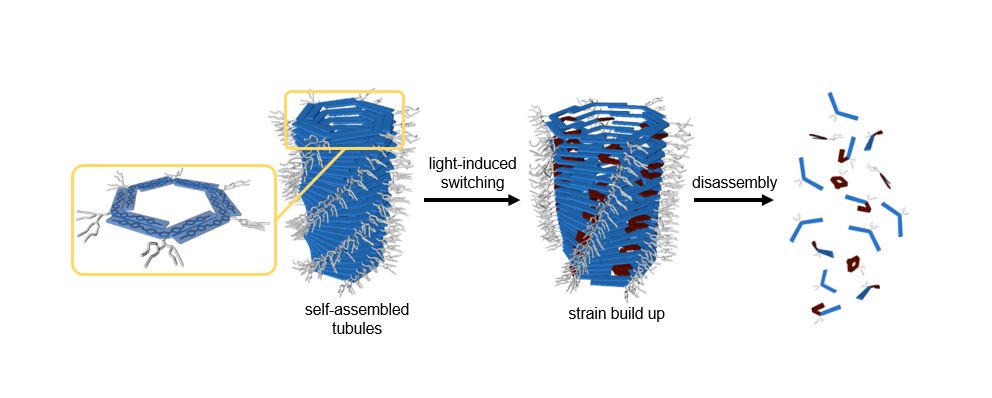Researchers at the University of Twente’s research institute MESA+ are constructing molecular machines capable of exerting a measurable force at nanoscale and in fluid environment. The design of these machines is based on self-assembling supramolecular tubules which can accumulate and store energy from light and convert it into a mechanical work.
The tubules were inspired by the biomolecular structures that transport molecular cargo in cells. The research has been published in the leading science journal PNAS.
Molecular machines – nano-sized devices that convert energy into movement – have been a global hot topic ever since Ben Feringa won the Nobel prize last year. It is a relatively new research field, but in nature molecular machines are found everywhere; for instance, they are responsible for muscle contraction, locomotion in sperm cells and bacteria, cell division, and DNA replication within the cell nucleus.
Self-assembly
Because of their extremely small scale, and the fact that most artificial molecular machines can only function when suspended in a liquid, it is generally impossible to harvest the force they can exert as they operate in a ‘stormy’ environment with the omnipresent (ubiquitous) Brownian motion (random motion of particles suspended in a fluid). Nevertheless, making these forces measurable is exactly what is needed to put them to use. Tibor Kudernac, University of Twente researcher and former colleague of Ben Feringa, therefore set himself the goal of developing synthetic molecular machines whose power could be measured and set to use. To achieve this, he directed himself towards supramolecular chemistry, and self-assembly in particular. Kudernac and his co-researchers have developed chemical building blocks that naturally clustertogether to form tubules, tube-like structures up to a micrometre long and few nanometres wide. When these tubules are illuminated with light, mechanical strain accumulate in their structure until a threshold value is exceeded and the structure abruptly falls apart, releasing the energy. In this way, the researchers succeeded in converting light energy into a stored strain energy that subsequently fuels the specific mechanical response.

Research
This research was carried out by Jean Fredy, Alejandro Méndez-Ardoy, Supaporn Kwangmettatam, Davide Bochicchio, Benjamin Matt, Marc Stuart, Jurriaan Huskens, Nathalie Katsonis, Giovanni Pavan and Tibor Kudernac of the Molecular Nanofabrication and Bio-inspired and Smart Materials research groups at the UT research institute MESA+, together with the University of Applied Sciences and Arts of Southern Switzerland and the University of Groningen.





